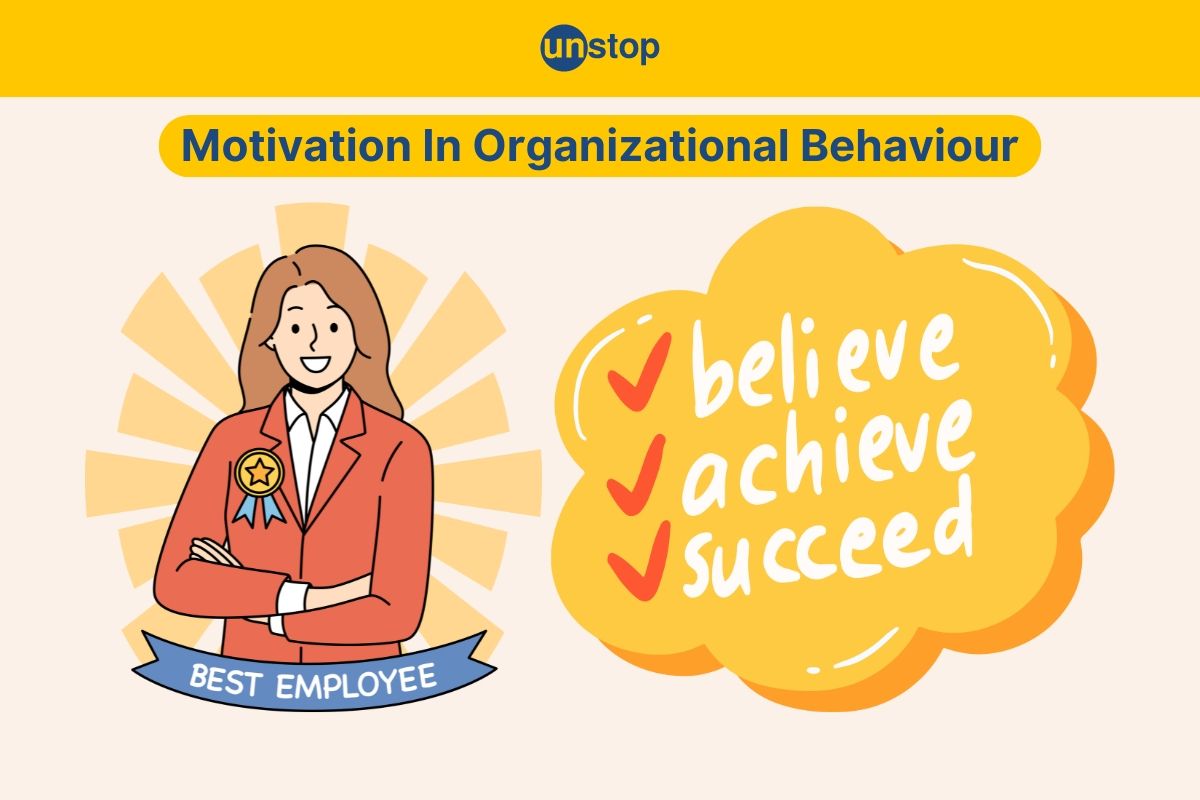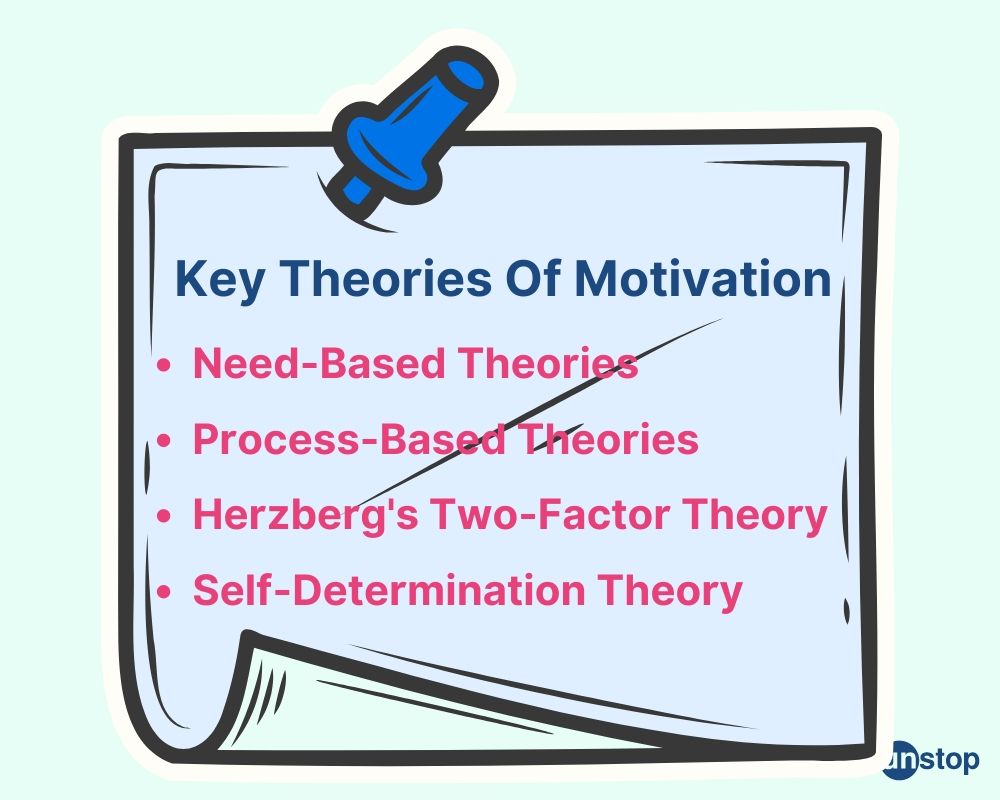- Definition Of Motivation In Organizational Behaviour
- Key Aspects Of Motivation In OB
- Importance Of Motivation In OB
- Types Of Motivation In OB
- Key Theories Of Motivation In Organizational Behaviour
- Tips To Enhance Motivation In OB
- Reinforcement In Motivation Strategies
- Conclusion
- Frequently Asked Questions (FAQs)
Motivation In Organizational Behaviour: Definition, Type & Theory

Understanding what motivates employees in an organization is key to boosting their performance and happiness at work, ultimately leading to greater success for the company.
Uncovering this driving factor sheds light on why employees act the way they do and how it impacts their overall job satisfaction and productivity.
Definition Of Motivation In Organizational Behaviour
Motivation in organizational behaviour (OB) refers to the internal and external factors that kickstart, direct, and uphold an individual's drive and determination to reach particular objectives.
It encompasses the psychological processes that arouse and direct goal-oriented behaviour, influencing how employees perform their tasks, interact with colleagues, and commit to organizational objectives.
Key Aspects Of Motivation In OB
Let us study the key aspects of motivation in organizational behaviour:
Initiation
Refers to what starts a person's behaviour. In an organizational context, this could be the beginning of a task, project, or any work-related activity.
Guidance
Involves the direction that behavior takes. Motivated employees are more likely to align their efforts with organizational goals and standards.
Sustainability
Concerns the persistence of behaviour over time. Motivation determines how long an employee can maintain their efforts towards achieving their goals despite challenges and obstacles.
Importance Of Motivation In OB

Let us study the importance and benefits of motivation in organizational behaviour:
-
Performance: Motivated employees tend to perform better, showing higher productivity and efficiency.
-
Engagement: High levels of motivation lead to increased engagement and involvement in work activities, promoting a proactive and enthusiastic work environment.
-
Job Satisfaction: Employees who feel motivated tend to be happier in their roles, resulting in reduced turnover and increased staff loyalty.
-
Innovation: Motivated employees are likelier to contribute innovative ideas and solutions, driving organizational growth and competitiveness.
-
Team Dynamics: Motivation influences how employees interact and collaborate, fostering teamwork and a positive organizational culture.
Types Of Motivation In OB
Let us study the types of motivation in organizational behaviour:
Intrinsic Motivation
Motivated by personal growth, recognition, and feeling accomplished, employees find the drive from within. Intrinsic motivation involves participating in tasks for personal fulfilment, like experiencing achievement or pleasure.
People who are intrinsically motivated feel fulfilled by the work they do rather than by receiving rewards from outside sources. This type of motivation often leads to increased creativity, determination, and overall enjoyment at work.
Extrinsic Motivation
Driven by external rewards, such as salary, bonuses, promotions, and other tangible benefits. Employees are motivated by the outcomes that come from completing tasks. Extrinsic motivation involves engaging in activities for external rewards such as money, praise, or recognition.
People motivated extrinsically focus on the outcome or reward associated with the task rather than the task itself. While extrinsic motivation can lead to short-term performance improvements, it may not sustain long-term engagement.
Key Theories Of Motivation In Organizational Behaviour
Let us study some of the important theories of motivation:

Need-Based Theories
Need-based theories focus on the psychological needs that drive individuals to perform certain actions. These theories emphasize the importance of fulfilling basic needs before advancing to higher-level ones.
Maslow's Hierarchy
Abraham Maslow's theory of needs, introduced in 1943, is crucial for understanding motivation. It suggests that people are driven by five levels of needs: physical, safety, social, self-esteem, and self-fulfilment.
This theory stresses the importance of meeting basic needs first before moving on to higher ones.
Process-Based Theories
On the other hand, process-based theories concentrate on how specific factors influence an individual's motivation. The Equity Theory, Expectancy Theory, and Goal-Setting Theory fall under this category.
Unlike need-based theories that revolve around fulfilling needs, process-based theories delve into the cognitive processes involved in motivating behaviour.
Herzberg's Two-Factor Theory
Herzberg's Two-Factor Theory, introduced in 1959 by Frederick Herzberg, focuses on key elements that influence employee attitude and motivation. It distinguishes between hygiene factors (such as job security and salary) and motivators (like recognition and growth opportunities).
According to this theory, satisfaction and dissatisfaction at work are influenced by separate factors.
Self-Determination Theory
The self-determination theory, created by Edward L. Deci and Richard M. Ryan in the 1980s, emphasizes how autonomy can enhance internal motivation. It identifies three main psychological needs: independence, competence, and social relationships. Meeting these needs can lead to increased intrinsic motivation among employees.
Tips To Enhance Motivation In OB
Let us study some of the tips to enhance motivation in organizational behaviour:

Promotion Opportunities
Rewarding employees with promotions for their hard work and dedication is key to keeping them motivated. When workers know that they can advance in their careers based on how well they perform, they tend to work harder and strive for success.
Participation In Decision-Making
Encouraging participation in decision-making processes empowers employees and gives them a sense of ownership. This involvement increases their relatedness to the organization's goals, fostering a deeper commitment.
Benefits & Outcomes
Linking performance to tangible outcomes such as rewards or recognition reinforces the belief that efforts will result in desirable consequences. This connection strengthens the positive relationship between input and output.
Humane Orientation
A humane orientation in leadership emphasizes empathy and understanding towards employees' needs and concerns. This approach creates a supportive environment where individuals feel valued, thereby increasing their motivation levels.
Future Growth Opportunities
Highlighting potential future growth opportunities based on employees' abilities and contributions instils a sense of purpose. Knowing that their efforts can lead to personal development fuels motivation to excel in their roles.
Reinforcement In Motivation Strategies
Let us study how reinforcement in motivation strategies works:
Positive Reinforcement
Positive reinforcement is a powerful tool in work motivation, encouraging employees to continue displaying desired behaviours. By offering rewards such as bonuses, recognition, or promotions, organizations can reinforce positive actions and boost morale.
This approach not only acknowledges hard work but also motivates individuals to strive for excellence. Implementing positive reinforcement strategies in the workplace can effectively shape employee behaviour and boost productivity.
Recognizing employees' efforts encourages them to continue performing well, ultimately leading to increased job satisfaction. Providing feedback on time and being clear helps encourage good behaviours and improve organizations.
Negative Reinforcement
Contrary to popular belief, negative reinforcement does not involve punishment but rather the removal of an unpleasant stimulus to strengthen desired behaviours. In the context of organizational behaviour, negative reinforcement can be seen as eliminating obstacles that hinder employee performance.
For example, removing strict deadlines once a project is completed successfully can reinforce employees' hard work and dedication.
Negative reinforcement techniques help influence employee behaviours by focusing on removing barriers that impede progress. By identifying and addressing factors that hinder performance, organizations can create a conducive environment for employees to thrive.
This approach emphasizes the importance of understanding individual needs and providing adequate support to enhance motivation levels.
Rewards And Punishment
Implementing a balanced mix of rewards and punishment can effectively shape employee behaviours and drive organizational success. While rewards like bonuses or promotions motivate employees to achieve results, punishments such as warnings or demotions deter undesirable actions.
Organizations must find a way to balance these two methods to keep open lines of communication with their employees.
Conclusion
Motivation in organizational behaviour is a critical factor influencing employee performance, engagement, and satisfaction. Understanding the types and theories of motivation provides valuable insights into what drives individuals. Ultimately, fostering a motivated workforce is essential for achieving organizational success and maintaining a positive, productive work environment.
Now that you've delved into various motivation theories, types, challenges, and strategies in organizational behaviour, you are empowered to create a more motivating work environment that fosters productivity and satisfaction. By addressing fairness, enhancing expectancy and equity, and implementing reinforcement strategies, you can boost motivation levels among your team members.
Frequently Asked Questions (FAQs)
1. What is the definition of motivation in organizational behaviour?
Motivation in organizational behaviour refers to the inner and outer influences that kickstart, direct, and uphold a person's drive and determination to reach particular objectives.
2. Why is motivation important in organizational behaviour?
Motivation is crucial because it affects performance, engagement, job satisfaction, innovation, and team dynamics, all of which are vital for organizational success.
3. Point out the difference between intrinsic and extrinsic motivation.
Internal rewards like personal growth and feeling accomplished fuel intrinsic motivation, whereas external rewards like salary, bonuses, and promotions drive extrinsic motivation.
4. How does motivation influence employee performance?
Motivated employees tend to perform better, showing higher productivity and efficiency in their tasks.
5. What are some strategies to enhance motivation in the workplace?
Strategies include providing clear goals, offering regular feedback, recognizing achievements, creating opportunities for professional development, and ensuring a fair and supportive work environment.
Suggested reads:
- Personality In Organizational Behaviour- Types, Theories And More
- Theory Of Personality- Definition And 6 Major Theories Explained
- Teamwork Skills- Definition, Types, Benefits & Success Strategies
- What Are The Barriers Of Communication | Types & Tips For Success
- Workplace Anxiety- Causes, Symptoms & Coping Strategies Explained
Instinctively, I fall for nature, music, humor, reading, writing, listening, traveling, observing, learning, unlearning, friendship, exercise, etc., all these from the cradle to the grave- that's ME! It's my irrefutable belief in the uniqueness of all. I'll vehemently defend your right to be your best while I expect the same from you!
Login to continue reading
And access exclusive content, personalized recommendations, and career-boosting opportunities.
Subscribe
to our newsletter
















Comments
Add comment